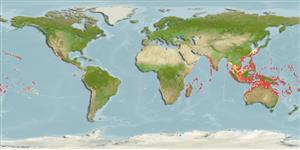Common names from other countries
>
Tetraodontiformes (Puffers and filefishes) >
Monacanthidae (Filefishes)
Etymology: Cantherhines: Greek, kanthos = the outer or inner corner of the eye, where the lids meet, 1646 + Greek, rhinos = nose (Ref. 45335).
Environment: milieu / climate zone / depth range / distribution range
Ecologia
marino associati a barriera corallina; non migratori; distribuzione batimetrica 0 - 70 m (Ref. 89467), usually 6 - 35 m (Ref. 9710). Tropical; 32°N - 32°S
Indo-Pacific: East Africa to French Polynesia, north to Japan and Hawaii. Eastern Pacific: Mexico to Colombia (Ref. 9318).
Size / Peso / Age
Maturity: Lm ? range ? - ? cm
Max length : 38.0 cm TL maschio/sesso non determinato; (Ref. 30573); common length : 25.0 cm TL maschio/sesso non determinato; (Ref. 30573)
Short description
Chiavi di identificazione | Morfologia | Morfometria
Spine dorsali (totale) : 2; Raggi dorsali molli (totale) : 34 - 39; Spine anali: 0; Raggi anali molli: 28 - 35. Greyish brown to yellowish brown with about 12 vertical dark brown bars; lips whitish; male adults with orange peduncle spines; soft dorsal, anal and pectoral fins pale yellowish; caudal fin orange with dusky rays (Ref. 4421). Sexually dimorphic with males having longer and deeper orange peduncular spines and deeper orange tail and eyes (Ref. 37816).
Inhabit offshore coral reefs usually solitary or in pairs (Ref. 5503, 48637). Common in surface waters around oceanic islands (Ref. 9318). Benthopelagic (Ref. 58302). Shy species, usually retreating quickly into caves or large crevices of the reef (Ref. 48637). Juveniles are pelagic, seen under floating objects (Ref. 9318). Feed on tips of branching corals, algae, sponges, sea urchins, and mollusks (Ref. 1602). Minimum depth reported taken from Ref. 128797.
Life cycle and mating behavior
Maturities | Riproduzione | Spawnings | Egg(s) | Fecundities | Larve
Myers, R.F., 1991. Micronesian reef fishes. Second Ed. Coral Graphics, Barrigada, Guam. 298 p. (Ref. 1602)
IUCN Red List Status (Ref. 130435)
CITES (Ref. 128078)
Not Evaluated
Threat to humans
Harmless
Human uses
Pesca: commerciale; Acquario: Commerciale
Strumenti
Special reports
Download XML
Fonti Internet
Estimates based on models
Preferred temperature (Ref.
115969): 24.3 - 28.9, mean 27.6 (based on 1090 cells).
Phylogenetic diversity index (Ref.
82804): PD
50 = 0.5002 [Uniqueness, from 0.5 = low to 2.0 = high].
Bayesian length-weight: a=0.02399 (0.01377 - 0.04179), b=2.93 (2.78 - 3.08), in cm Total Length, based on LWR estimates for this species & (Sub)family-body (Ref.
93245).
Trophic level (Ref.
69278): 3.1 ±0.33 se; based on food items.
Resilienza (Ref.
120179): Medio, tempo minimo di raddoppiamento della popolazione 1.4 - 4.4 anni (Preliminary K or Fecundity.).
Fishing Vulnerability (Ref.
59153): Low to moderate vulnerability (28 of 100).
